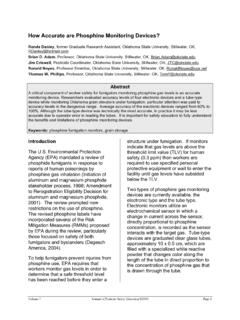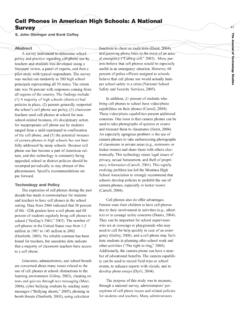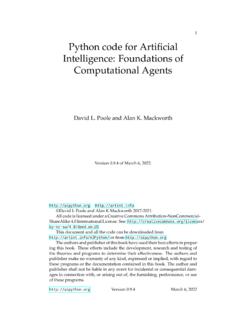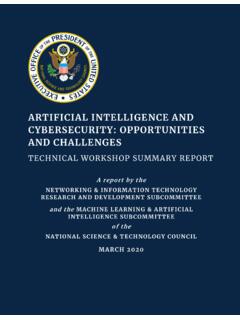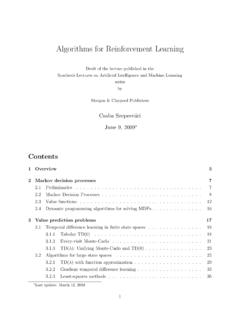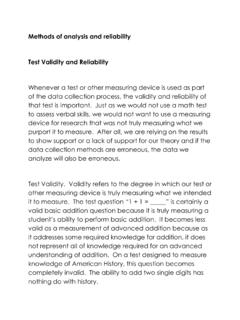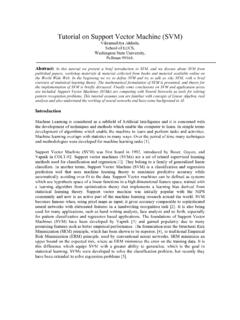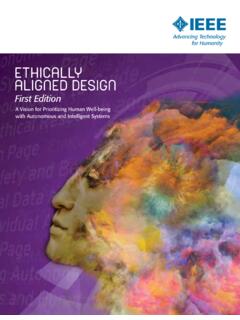Transcription of Social Reconstruction Curriculum and Technology Education
1 Journal of Technology EducationVol. 3 No. 2, Spring 1992 Social Reconstruction Curriculumand Technology EducationKaren F. Zuga.. to shape the experiences of the young so that instead of reproducing currenthabits, better habits shall be formed, and thus the future adult society be animprovement on their own. (Dewey, 1916, p. 79)In the first half of the century, during the depths of the Great Depression,Progressive educators set out to reform Education by calling for a Social re-construction Curriculum orientation. In this paper I will explore Social recon-struction with regard to schools, Curriculum , and Technology Education .
2 In thefirst half of the paper I will explore what was meant by Social Reconstruction ,the way in which it was implemented in experimental schools, and the legacyof Social Reconstruction . In the second half of the paper I will discuss the roleof processes in Technology Education Curriculum , provide ideas for organizinga Social Reconstruction Curriculum orientation in Technology Education , and listexamples of what a Social Reconstruction Curriculum orientation in technologyeducation is ReconstructionIn response to Social conditions of the day, Progressive educators duringthe early half of the century were advocating a restructuring of Education in thiscountry.
3 Many of the Progressives believed that, due to school practices,schools and society were caught in a dualistic relationship which separated theschool from mainstream society and created an isolation of the schools. Theybelieved that what happened under the auspices of the schools was not real orreflective of the problems in society (Bode, 1933; Counts, 1932; Cremin, 1977;Dewey, 1916; Dewey and Childs, 1933). Furthermore, the Progressives arguedthat the artificial environment of the schools was miseducative in that the youthof the country were not prepared to see and understand the values and issueswhich would confront them as they became adults (Dewey and Childs, 1933).
4 As a result of these beliefs, some Progressives proposed that the schools createa new Social order (Counts, 1932).Karen Zuga is Associate Professor, Department of Educational Studies, The Ohio State University,Columbus, 48 -Journal of Technology EducationVol. 3 No. 2, Spring 1992 DefinitionCreating a new environment in the schools, reconstructing the existingenvironment, was the Progressive agenda, but how that was to be accomplishedwas not universally agreed upon (Cremin, 1976). As with any other idea, arange of opinions were held with Counts proffering, perhaps, the most radicalopinion.
5 Counts (1932) envisioned a restructuring of American society andeconomy as he said, The times are literally crying for a new vision of Ameri-can destiny. The teaching profession, or at least its progressive elements,should eagerly grasp the opportunity which the fates have placed in theirhands. (p. 50) Others were less radical in their suggestions for reform, but didbelieve that Social Reconstruction was the central aim of a good Education andwas necessary in schools, if not, society at that many members of society were far too concerned with indi-vidual needs, that the fervent nationalism of the times inhibited internationalcooperation, and that the economic depression was signalling problems with theexisting society and economic structure (Dewey and Childs, 1933)
6 MainstreamProgressives believed that the schools could be structured in a new way, and,in turn, encourage students as future citizens to reconstruct society. The focusof mainstream Progressives was on the restructuring of schools; an effort whichmany hoped would lead to eventual changes in society. For schools and stu-dents, mainstream Progressive educators had several goals which included:orienting students and helping them commit to the life in which they wouldparticipate; helping students to develop intellectual, esthetic, or practical inter-ests; setting up an environment which would lead to a deeper understandingof a democratic way of life; and reconstructing the procedures of the schoolthrough experimentalism (Hullfish, 1933).
7 Mainstream Progressive educatorsdiffered with Counts in that they saw a future for the existing the Social Reconstruction of the mainstream Progressives, Dewey andChilds (1933) said:Our continued democracy of life will depend upon our own power of characterand intelligence in using the resources at hand for a society which is not so muchplanned as planning --- a society in which the constructive use of experimentalmethod is completely naturalized. In such a national life, society itself wouldbe a function of Education , and the actual educative effect of all institutionswould be in harmony with the professed aims of the special educational insti-tution.
8 (Dewey and Childs, 1933, p. 65)Interestingly, the Progressives based their interpretation of Social recon-struction in experimentalism, science, and Technology . Experimentalism andfaith in science and Technology are fundamental to the philosophy of pragma-tism. As a leading pragmatic philosopher, Dewey conceived of pragmatism asa uniquely American philosophy which dealt with the concepts of theinstrumentalism of Technology and the experimentalism of science as inquiry(Hickman, 1990; Smith, 1980). It is no wonder, then, that Dewey advocatedexperimentation in schools for both the students via the Curriculum and for- 49 -Journal of Technology EducationVol.
9 3 No. 2, Spring 1992administrators as they determined the structure of schools. Moreover, Deweyand Childs (1933) spoke of the use of instrumentalism as a Technology of edu-cation which would influence society: An identity, an equation, exists betweenthe urgent Social need of the present and that of Education . Society, in orderto solve its own problems and remedy its own ills, needs to employ science andtechnology for Social instead of merely private ends. ( ) Make no mistakeabout it, though, the purpose of the use of science and Technology was to be asocial purpose, not an individual purpose and not a business purpose.
10 Individ-ual and business values and actions were clearly criticized by the Progressiveswho linked these values and actions to the evident ills within society during thefirst half of the century (Bode, 1933; Counts, 1932; Dewey and Childs, 1933).ImplementationA number of experimental or laboratory schools were set up during theProgressive Era in Education . It is from these schools that examples of whatsocial Reconstruction would look like in Education can be drawn. Bode (1933)explains Social Reconstruction as a continuous Reconstruction of experience ( ) in daily school practice with the following examples:This Reconstruction of experience, if it is to have any significance, must take theform of actual living and doing.
